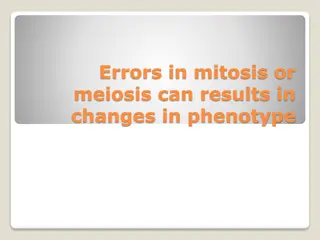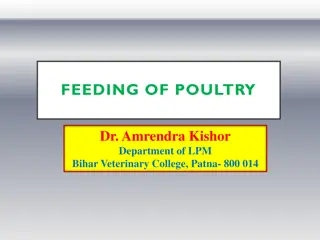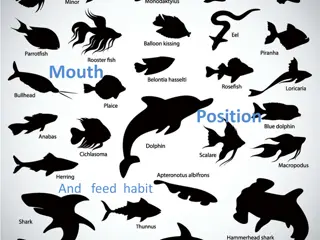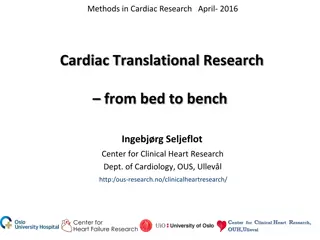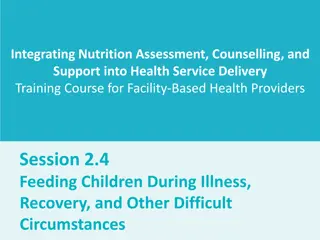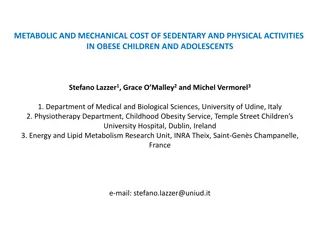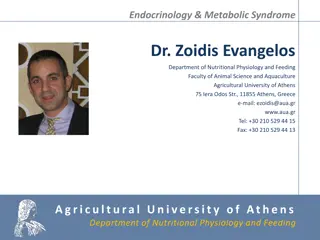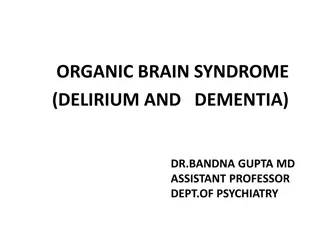Understanding Re-feeding Syndrome: Metabolic Alterations and Pathophysiology
Re-feeding Syndrome (RS) is a critical condition characterized by severe metabolic changes during the repletion of underweight or malnourished individuals. The syndrome's hallmark is severe hypophosphatemia, leading to multisystem complications. This summary delves into the biochemical basis of RS, the physiology of starvation, risk factors, and the pathological challenges associated with both starvation and re-feeding.
Download Presentation

Please find below an Image/Link to download the presentation.
The content on the website is provided AS IS for your information and personal use only. It may not be sold, licensed, or shared on other websites without obtaining consent from the author. Download presentation by click this link. If you encounter any issues during the download, it is possible that the publisher has removed the file from their server.
E N D
Presentation Transcript
Re-feeding Syndrome Sunday Pam
What is RS? Metabolic alterations that occur during nutrition repletion of underweight, severely malnourished or starved individuals. Hallmark is severe hypophosphataemia and associated complications Multisystemic manifestations Classic reports on WWII objectors
Why RS? Biochemical Basis of RS Phosphate Magnesium Potassium Thiamine ?Protein Others Calcium, Sodium, Acidosis
Physiology of starvation 24-72 hours Gluconeogenesis from liver & muscle for glucose- dependent energy for brain, rbc, renal medulla. Post 72 hours ketones from FFA with protein sparing Glycogenolysis BMR Secretion of Insulin FFA use by brain as primary energy source
Physiology of Starvation 2 Others Thyroid functions antidiuretic hormone Growth Hormone Hyperaldostronaemia Hypercortisolaemia
Risk factors Anorexia nervosa Classic marasmus/kwashiorkor Chronic diseases eg neoplasia, FTT(Failure to Thrive) Morbid obesity with massive weight loss Starvation for short periods from stress
Pathological challenges in starvation Cardiac volume, mass and electrical function compromised Intestinal atrophy Impaired synthesis of B-lipoprotein leads to Fatty liver Pancreatic atrophy Exocrine +/-endocrine
Pathophysiology of Refeeding Feeding by any means Glucose surge Increased glucose metabolism Increased demand for phosphorylated intermediates Increased cellular uptake of phosphates Pre-existing low phosphates Hypophosphataemia
Issue of fluid Complex interplay between Na+, H2O & CHO Antidiuretic effect of insulin Low GFR Weak myocardium Effects of PO4, K+, Mg2+ Others BMR Muscle activity Perivascular fluid mobilisation ? Protein synthesis
Clinical manifestations of RS Hypophosphataemia-Occur with PO4 levels <0.5mmol/L O2 transport/delivery Cardiac function Diaphragmatic contractility Respiratory failure Paraesthesias Somnolence Confusion Seizures Coma
Clinical manifestations 2 Arrhythmias Atrial Tachycardia Bradycardia Atrioventricular block PVC V Tach V Fib Hypokalaemia- <2.5mmol/L Nausea/vomiting Weakness Paralysis Rhabdomyolysis Muscle necrosis ECG-ST , T flat or , U waves
Clinical manifestations 3 ECG Arrhythmias A Fib Torsades de pointes V fib V tach Hypomagnesaemia Serum<1.5mg/dL Cofactor in oxidative phosphorylation HypoMg complicates Rx of K+ and PO4 Weakness Muscle twitching Tremor Diarrhoea Refractory K+ PO4 Tetany Seizures Coma PR QRS QT ST
Clinical manifestations 4 Thiamine/?other vitamins Lactic acidosis Encephalopathy Sodium and fluid Complex consequence Fluid retention Pulmonary oedema Cardiac failure
Prevention Identify those at risk Long standing malnutrition Severe wt loss Avoid over zealous re-feeding Start slow and Go slow *Correct any electrolyte abnormality before starting Cautious monitoring and correction of electrolyte imbalance Vitamin supplements Interrupt feeding if RS manifests
Approach to Treatment Look out for features of RS Thiamine for neurologic features Respiratory distress O2 Fluid overload Diuretics Weight adjustment (ideal body weight)
Rx Hypophosphataemia PO4 doses largely empiric Oral route preferred if possible May cause diarrhoea Absorption unreliable Suitable for mild cases Parenteral for symptomatic/Severe Monitor serum in 2-4hrly initially, dly later Thrombophlebitis, hypocalcaemia
Rx HypoPO4 2 Degree of hypoPO4 mg/dL IV PO4 dosage mmol/kg 2.3-2.7 0.08-0.16 1.5-2.2 0.16-0.32 <1.5 0.32-0.64
Rx Hypokalaemia Oral route feasible when mild Unpleasant taste and Diarrhoea Severe case <2.5mmol/L Parenteral at 0.3-0.5mmol/kg/hr Faster rates with ECG monitoring Must correct hypomagnesaemia to succeed Maximum concentration for peripheral vein infusion 80mmol/L Monitor serum levels closely
Rx hypomagnesaemia IV route preferred in severe cases Poor tissue distribution Rapid renal clearance Total correction requires several days 1-1.5mmol/kg over 2-6 hours(maximum 8.1mmol/hour). Some recommend 6-12 hrs. Too rapid infusion urinary loss Serum levels after 12-24hrs
Restarting nutrition Caution All electrolyte abnormalities must be treated Electrolytes suppl to be higher than doses @ onset of RS Must be symptom free before restarting Multivitamin suppl Initiate feeds at <50% pre-RS rate, reach goal in 4-5 days Close monitoring for repeat RS
Restarting feeds 2 Calories up 175kcal/kg/day Protein up to 4g/kg/day Micronutrient repletion Reach goal in about 1 week
Bibliography Kraft MD et al. Review of Refeeding syndrome. Nutr Clin Pract 2005;20:625-33 Hearing S. Refeeding syndrome. BMJ 2004; 328;908-9. Korbonits M et al. Metabolic and hormonal changes during refeeding period of prolonged fasting. Eur J Endocrinol 2007;157;157-166. Dunn R et al. Refeeding sndroe in hospitalized Pediatric Patients. Nutr Clin Pract 2003;18:327 Refeeding synrdrome. Wikipedia El-Sayel HL. Structural and functional affection of the heart in protein energy malnutrition patients on admission and after nutritional recovery. Eur J Clin Nutr 2006; 60:502-10.






